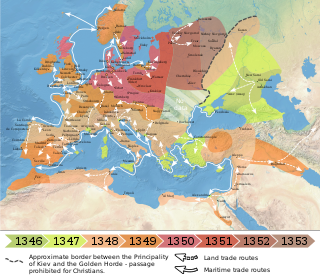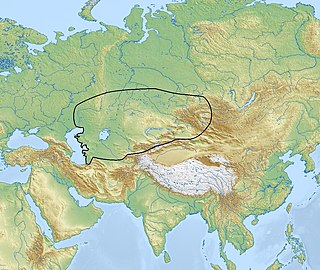Related Research Articles

The Black Death was a bubonic plague pandemic occurring in Europe from 1346 to 1353. It was one of the most fatal pandemics in human history; as many as 50 million people perished, perhaps 50% of Europe's 14th century population. The disease is caused by the bacterium Yersinia pestis and spread by fleas and through the air. One of the most significant events in European history, the Black Death had far-reaching population, economic, and cultural impacts. It was the beginning of the second plague pandemic. The plague created religious, social and economic upheavals, with profound effects on the course of European history.

Plague is an infectious disease caused by the bacterium Yersinia pestis. Symptoms include fever, weakness and headache. Usually this begins one to seven days after exposure. There are three forms of plague, each affecting a different part of the body and causing associated symptoms. Pneumonic plague infects the lungs, causing shortness of breath, coughing and chest pain; bubonic plague affects the lymph nodes, making them swell; and septicemic plague infects the blood and can cause tissues to turn black and die.

Yersinia pestis is a gram-negative, non-motile, coccobacillus bacterium without spores that is related to both Yersinia enterocolitica and Yersinia pseudotuberculosis, the pathogen from which Y. pestis evolved and responsible for the Far East scarlet-like fever. It is a facultative anaerobic organism that can infect humans via the Oriental rat flea. It causes the disease plague, which caused the Plague of Justinian and the Black Death, the deadliest pandemic in recorded history. Plague takes three main forms: pneumonic, septicemic, and bubonic. Yersinia pestis is a parasite of its host, the rat flea, which is also a parasite of rats, hence Y. pestis is a hyperparasite.

Septicemic plague is one of the three forms of plague, and is caused by Yersinia pestis, a gram-negative species of bacterium. Septicemic plague is a systemic disease involving infection of the blood and is most commonly spread by bites from infected fleas. Septicemic plague can cause disseminated intravascular coagulation and is always fatal when untreated. The other varieties of the plague are bubonic plague and pneumonic plague.

The plague of Justinian or Justinianic plague was an epidemic that afflicted the entire Mediterranean Basin, Europe, and the Near East, severely affecting the Sasanian Empire and the Byzantine Empire, especially Constantinople. The plague is named for the Byzantine Emperor Justinian I, who according to his court historian Procopius contracted the disease and recovered in 542, at the height of the epidemic which killed about a fifth of the population in the imperial capital. The contagion arrived in Roman Egypt in 541, spread around the Mediterranean Sea until 544, and persisted in Northern Europe and the Arabian Peninsula until 549. By 543, the plague had spread to every corner of the empire. As the first episode of the first plague pandemic, it had profound economic, social, and political effects across Europe and the Near East and cultural and religious impact on Eastern Roman society.

The Andronovo culture is a collection of similar local Late Bronze Age cultures that flourished c. 2000–1150 BC, spanning from the southern Urals to the upper Yenisei River in central Siberia. Some researchers have preferred to term it an archaeological complex or archaeological horizon. The slightly older Sintashta culture, formerly included within the Andronovo culture, is now considered separately to Early Andronovo cultures. Andronovo culture's first stage could have begun at the end of the 3rd millennium BC, with cattle grazing, as natural fodder was by no means difficult to find in the pastures close to dwellings.

Yersinia pseudotuberculosis is a Gram-negative bacterium that causes Far East scarlet-like fever in humans, who occasionally get infected zoonotically, most often through the food-borne route. Animals are also infected by Y. pseudotuberculosis. The bacterium is urease positive.

Bubonic plague is one of three types of plague caused by the bacterium Yersinia pestis. One to seven days after exposure to the bacteria, flu-like symptoms develop. These symptoms include fever, headaches, and vomiting, as well as swollen and painful lymph nodes occurring in the area closest to where the bacteria entered the skin. Acral necrosis, the dark discoloration of skin, is another symptom. Occasionally, swollen lymph nodes, known as "buboes", may break open.

Eske Willerslev is a Danish evolutionary geneticist notable for his pioneering work in molecular anthropology, palaeontology, and ecology. He currently holds the Prince Philip Professorship in Ecology and Evolution at University of Cambridge, UK and the Lundbeck Foundation Professorship in Evolution at Copenhagen University, Denmark. He is director of the Centre of Excellence in GeoGenetics, a research associate at the Wellcome Trust Sanger Institute, and a professorial fellow at St John's College, Cambridge. Willerslev is a foreign associate of the National Academy of Sciences (US) and holds the Order of the Dannebrog issued by her Majesty Queen Margrethe II of Denmark in 2017.

The Black Death was one of the most devastating pandemics in human history, resulting in the deaths of an estimated 75 to 200 million people in Eurasia, and peaking in Eurasia from 1321 to 1353. Its migration followed the sea and land trading routes of the medieval world. This migration has been studied for centuries as an example of how the spread of contagious diseases is impacted by human society and economics.
Theories of the Black Death are a variety of explanations that have been advanced to explain the nature and transmission of the Black Death (1347–51). A number of epidemiologists from the 1980s to the 2000s challenged the traditional view that the Black Death was caused by plague based on the type and spread of the disease. The confirmation in 2010 and 2011 that Yersinia pestis DNA was associated with a large number of plague sites has led researchers to conclude that "Finally, plague is plague."

The Black Death was a bubonic plague pandemic, which reached England in June 1348. It was the first and most severe manifestation of the second pandemic, caused by Yersinia pestis bacteria. The term Black Death was not used until the late 17th century.
The 1994 plague in India was an outbreak of bubonic and pneumonic plague in south-central and western India from 26 August to 18 October 1994. 693 suspected cases and 56 deaths were reported from the five affected Indian states as well as the Union Territory of Delhi. These cases were from Maharashtra, Gujarat, Karnataka, Uttar Pradesh, Madhya Pradesh and New Delhi. There are no reports of cases being exported to other countries.
Plasminogen activator Pla is an enzyme. This enzyme catalyses the following chemical reaction

The 1924 Los Angeles pneumonic plague outbreak was an outbreak of the pneumonic plague in Los Angeles, California that began on September 28, 1924, and was declared fully contained on November 13, 1924. It represented the first time that the plague had emerged in Southern California since plague outbreaks had previously surfaced in San Francisco and Oakland. The suspected reason for this outbreak was a rat epizootic where squirrels that were found to be plague infected were secondarily infected by rats. Due to the evidence of infected squirrels near San Luis Obispo County as late as July 1924 and the migration habits of both squirrels and rats, it is thought that squirrels were the original source of the plague outbreak in Los Angeles.

Johannes Krause is a German biochemist with a research focus on historical infectious diseases and human evolution. Since 2010, he has been professor of archaeology and paleogenetics at the University of Tübingen. In 2014, Krause was named a founding co-director of the new Max Planck Institute for the Science of Human History in Jena.

Madagascar has experienced several outbreaks of bubonic and pneumonic plague in the 21st century. In the outbreak beginning in 2014, 71 died; in 2017, 202 died. Smaller outbreaks occurred in January 2008, and December 2013.
Globally about 600 cases of plague are reported a year. In 2017 and November 2019 the countries with the most cases include the Democratic Republic of the Congo, Madagascar, and Peru.
Kirsten Bos is a Canadian physical anthropologist. She is Group Leader of Molecular Palaeopathology at the Max Planck Institute for Evolutionary Anthropology in Leipzig. Her research focuses on ancient DNA and infectious diseases.
Ancientpathogengenomics is a scientific field related to the study of pathogen genomes recovered from ancient human, plant or animal remains. Ancient pathogens are microorganisms, now extinct, that in the past centuries caused several epidemics and deaths worldwide. Their genome, referred to as ancient DNA (aDNA), is isolated from the burial's remains of victims of the pandemics caused by these pathogens.
References
- 1 2 3 4 5 6 7 8 9 10 11 12 Rascovan, Nicolás; Sjögren, Karl-Göran; Kristiansen, Kristian; Nielsen, Rasmus; Willerslev, Eske; Desnues, Christelle; Rasmussen, Simon (2019-01-10). "Emergence and Spread of Basal Lineages of Yersinia pestis during the Neolithic Decline". Cell. 176 (1–2): 295–305.e10. doi: 10.1016/j.cell.2018.11.005 . ISSN 0092-8674. PMID 30528431.
- 1 2 3 4 Zhang, Sarah (6 December 2018). "An Ancient Case of the Plague Could Rewrite History". The Atlantic. Retrieved 13 November 2019.
- 1 2 "The excavation of the Neolithic site at Hamin Mangha in Horqin Left Middle Banner, Inner Mongolia in 2011". Chinese Archaeology. 14 (1): 10–17. 2014-11-17. doi:10.1515/char-2014-0002. ISSN 2160-5068.
- 1 2 3 Colledge, Sue; Conolly, James; Crema, Enrico; Shennan, Stephen (2019-01-10). "Neolithic population crash in northwest Europe associated with agricultural crisis". Quaternary Research. 92 (3): 686–707. Bibcode:2019QuRes..92..686C. doi:10.1017/qua.2019.42. ISSN 0033-5894. S2CID 202186375.
- 1 2 3 4 5 6 Rasmussen, Simon; Allentoft, Morten Erik; Nielsen, Kasper; Orlando, Ludovic; Sikora, Martin; Sjögren, Karl-Göran; Pedersen, Anders Gorm; Schubert, Mikkel; Van Dam, Alex; Kapel, Christian Moliin Outzen; Nielsen, Henrik Bjørn; Brunak, Søren; Avetisyan, Pavel; Epimakhov, Andrey; Khalyapin, Mikhail Viktorovich (2015-01-10). "Early divergent strains of Yersinia pestis in Eurasia 5,000 years ago". Cell. 163 (3): 571–582. doi:10.1016/j.cell.2015.10.009. PMC 4644222 . PMID 26496604.
- 1 2 3 4 Zhou, Yawei; Niu, Xiaohui; Ji, Ping; Zhu, Yonggang; Zhu, Hong; Zhang, Meng (2022-06-28). "The Hamin Mangha Site: Mass Deaths and Abandonment of a Late Neolithic Settlement in Northeastern China". Asian Perspectives. 61 (1): 28–49. doi:10.1353/asi.2022.0002. ISSN 1535-8283. S2CID 250270682.
- ↑ Jarus, Owen (27 Jul 2015). "Gruesome Find: 100 Bodies Stuffed into Ancient House". livescience.com. Retrieved 2021-04-12.
- 1 2 Susat, Julian; et al. (2021-06-29). "A 5,000-year-old hunter-gatherer already plagued by Yersinia pestis". Cell Reports. 35 (13): 109278. doi: 10.1016/j.celrep.2021.109278 . ISSN 2211-1247. PMID 34192537. S2CID 235697166.